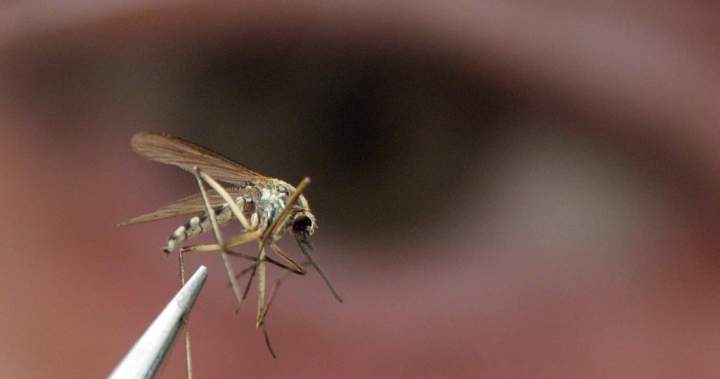Uncategorized
Montreal man pleads not guilty to murder charge in daughter’s death

The Montreal man facing a murder charge in New York state in the death of his nine-year-old daughter has pleaded not guilty and will remain in custody until his next court appearance later this week.
Luciano Frattolin was represented by the Essex County Public Defenders Office and remanded to Essex County Jail until Friday at 1 p.m. eastern daylight time.
Frattolin was arrested on Monday, with New York State Police announcing later that the 45-year-old had been charged with second-degree murder and concealment of a corpse in connection with the death of Melina Frattolin.
The two had been in the U.S. since July 11, visiting Connecticut and New York City before heading to upstate New York on Saturday.
New York State Police Capt. Robert McConnell told reporters a man reported his nine-year-old daughter missing on Saturday from the area of Exit 22 of I-87 in Lake George, N.Y., possibly due to an abduction.
“His initial report (was that) as he steps away to a wooded area, returns (to) the vehicle, and at that point, his child is gone from the vehicle. He reports a suspicious white van fleeing the scene southbound during a subsequent interview. He then reports two unknown males forced her into a white van.”

Get breaking National news
For news impacting Canada and around the world, sign up for breaking news alerts delivered directly to you when they happen.
McConnell alleged Frattolin attempted to hide Melina’s body in the woods in Ticonderoga.
Hank Idsinga, a former homicide detective with the Toronto Police Service, told Global News there are treaties that allow co-operation between police services on both sides of the border for investigations like this.
He said investigators will potentially look at Frattolin’s residence, social media, computer and cellphone downloads and even cellphone records.
“You really want to rebuild the last 24, 48 hours of the suspect’s life and a victim’s life and have it ready to go for court,” Idsinga said.
Idsinga said New York police would need to rely on authorities in Montreal, however, to conduct any investigative steps in the city, as they have no power to do so.
McConnell told reporters that while he can’t speak to the prosecution, he said Frattolin would be charged and prosecuted in the state.
Canada and the U.S. have an extradition treaty allowing for one country to extradite a person to the other based on a request.
According to Idsinga, the “only possibility” of Frattolin being returned to Canada would be to serve a sentence.
“But that’s pretty unusual as well when it’s an American-Canadian type of scenario,” he said.
— with files from Global News’ Kevin Nielsen, Touria Izri and Marc-Andre Cossette.
© 2025 Global News, a division of Corus Entertainment Inc.
Uncategorized
West Nile virus is back. Where it’s been found, and what you should know

West Nile virus has returned to Canada for another season, with detections in mosquitoes in multiple regions of Ontario in the past week, including in Toronto.
Niagara Region Public Health confirmed Tuesday that West Nile virus had been detected in mosquitoes in Welland, Ont., while Toronto and York Region reported their first positive cases in the insects late last week.
No human cases of the virus have been reported in Canada as of Wednesday, but that isn’t stopping health-care professionals from urging caution.
“Nobody wants to get bit by mosquitoes, whether or not they’re causing fever,” said Dr. Isaac Bogoch, an infectious diseases specialist at Toronto General Hospital.
What are the symptoms of West Nile virus?
West Nile virus first arrived in Canada in August 2002, according to Infection Prevention and Control Canada (IPAC).
IPAC says the virus primarily infects birds and is then spread to humans by mosquitoes that have fed on the blood of those birds.
Though no human cases have been reported in Canada so far this year, Bogoch said they are typically seen in mid- to late summer and into early fall.
In those that the virus does infect, about 70 to 80 per cent may not even realize they have it, as they will have no symptoms.

Get weekly health news
Receive the latest medical news and health information delivered to you every Sunday.
But those who do will typically experience symptoms like a fever, a headache, body aches, a mild rash and swollen lymph glands.
The symptoms usually appear within two to 15 days after infection.

The Public Health Agency of Canada says less than one per cent of people infected with the virus will develop severe symptoms and health effects.
PHAC says people 50 years and older, those with chronic diseases like cancer and heart disease, and those with weakened immune systems are at higher risk of severe symptoms.
In severe cases, people can face the rapid onset of a severe headache, a high fever, a stiff neck, nausea or vomiting, difficulty swallowing, drowsiness or confusion.
PHAC says loss of consciousness, lack of co-ordination, muscle weakness or paralysis are also possible in severe cases.
“Rarely it can cause neurologic manifestations and that can be more severe,” Bogoch said.
“It can cause inflammation of the brain, inflammation of the area around the brain and spinal cord, a meningitis-type picture, and then it can also rarely cause a paralysis-type syndrome that’s really reminiscent of polio.”
Canadian Family Physician, the official publication of the College of Family Physicians of Canada, notes that three to 15 per cent of those with severe illness can die.
“It’s extremely rare, but again it’s no laughing matter,” Bogoch said.
Mild cases typically take a week to recover, but PHAC says some severe cases could see a variety of health effects that could last months to years after illness.
People who develop symptoms of West Nile after being bitten by a mosquito are urged to see their health-care provider immediately.
The risk of becoming infected with West Nile virus starts in mid-April and lasts typically until the first hard frost in either late September or October.
The highest risk period for humans is between mid-July and early September, with mosquitoes often most active at dawn and dusk.
PHAC says when outside, people should cover exposed skin by wearing long pants and loose-fitting, long-sleeved shirts, socks and a hat. People should also wear light-coloured clothing, as PHAC notes mosquitoes are attracted to dark colours.
People are also encouraged to use insect repellents containing DEET or icaridin, which can also help prevent bites.
The health agency says Canadians can also take steps to reduce mosquitoes near their home, namely by getting rid of standing water around their home and putting screens on their windows and doors.
However, while West Nile can be a concern, Bogoch says it shouldn’t prevent Canadians from enjoying the summer, whether they’re at the beach, at a cottage or enjoying summer camp.
“We should be outside and enjoying it as much as possible, because winter is unfortunately around the corner as well,” he said. “But no reason to hide indoors because of this. Just go outside, have a wonderful time, be aware that they’re there.”
© 2025 Global News, a division of Corus Entertainment Inc.
Uncategorized
Ontario children hospitalized after consuming cannabis edibles in Sagamok First Nation

A 45-year-old man from Sagamok First Nation has been charged after two children under the age of five were hospitalized with cannabis poisoning earlier this year.
The incident occurred on March 22, 2025, when officers with the Anishinabek Police Service responded to a call for assistance at a home in the community.
Upon arrival, police learned that the children had consumed large cannabis-infused gummies that had been left in a plastic bag on a table, according to the release. Each gummy was approximately the size of a cellphone, and police say one child consumed an entire piece while the second ate half of one.
The remaining gummies were seized from the residence.
Both children were exhibiting serious symptoms of cannabis toxicity and were transported to hospital, where they were admitted to the intensive care unit.
Authorities confirmed that the children have since recovered and been released from care.

Get breaking National news
For news impacting Canada and around the world, sign up for breaking news alerts delivered directly to you when they happen.
Following a lengthy investigation, police charged the man with two counts of criminal negligence causing bodily harm. He has been released on a Form 9, a legal document that compels an individual to appear in court at a later date.
The case has sparked renewed warnings from health officials about the dangers of cannabis ingestion in children, particularly involving edible products that resemble candy or snacks.
According to the Ontario Poison Centre, hospitals have seen a significant increase in emergency room visits related to accidental cannabis poisonings.
While cases have occurred in children up to age 12, most involve children under five. Ingestion of cannabis by a child can lead to serious health consequences, including loss of consciousness, difficulty breathing, and, in extreme cases, coma or death.
Officials emphasize that unregulated cannabis edibles are especially dangerous due to their packaging, which often mimics popular brands and features colourful, attractive designs that appeal to children.
These products typically lack child-resistant packaging and often contain high levels of THC.
To reduce the risk of accidental ingestion, authorities are urging cannabis users to store all products securely in clearly-labelled, locked containers, separate from food and drinks and out of reach for children.
Legal cannabis products are required to be sold in child-resistant packaging, but even these must be handled with care.
Extra precautions should also be taken in households with visiting children, including checking whether caregivers, relatives or babysitters store cannabis safely.
Common signs of cannabis poisoning in children include vomiting, drowsiness, increased heart rate, difficulty breathing, anxiety, and confusion.
Parents or guardians who suspect their child has ingested cannabis are urged to seek medical attention immediately or call 911.
Anyone with information related to this case is asked to contact the Anishinabek Police Service.
© 2025 Global News, a division of Corus Entertainment Inc.
Uncategorized
Rogers looks for cost savings in sports portfolio after becoming MLSE majority owner

Rogers Communications Inc. hopes to find “revenue and cost synergies” in its expanded portfolio of sports assets after becoming the majority owner of Maple Leaf Sports & Entertainment.
The Toronto-based telecom company believes its stock price undervalues its media and sports holdings and says it is “pursuing all options … to monetize and surface the very substantial unrecognized market value” of those assets.
Earlier this month, Rogers completed its $4.7-billion deal with rival BCE Inc. to buy its 37.5 per cent stake in MLSE. The acquisition, which closed July 1 after receiving the necessary regulatory and league approvals, made Rogers the majority owner of the sports conglomerate that owns the NHL’s Maple Leafs, NBA’s Raptors, CFL’s Argonauts, MLS’ Toronto FC and AHL’s Marlies.
Rogers also owns MLB’s Toronto Blue Jays.
“On sports and media, it’s clear that there is significant underlying value and we are squarely focused as we put the assets together … to continue to strengthen our balance sheet,” said Rogers president and CEO Tony Staffieri on a conference call Wednesday, as the company reported its latest earnings.
“The second part of our task is to surface the value for shareholders. We continue to work through the various options and the good news is we have very good options in front of us.”

Staffieri said it was premature to provide further insight about possible “synergies” within MLSE, but that Rogers would likely share details of its plans before the end of 2026.

Get breaking National news
For news impacting Canada and around the world, sign up for breaking news alerts delivered directly to you when they happen.
He said Rogers has “a very good track record” in finding ways to operate more efficiently, pointing to its 2023 merger with Shaw Communications Inc.
“We went into this transaction with a view that we could execute on very strong synergies across our sports and media properties and certain things that need to happen before we can execute on those,” he said.
“But the thinking, the planning is underway and at the right time … we can be more specific.”
Some industry watchers have speculated about the potential for Rogers to eventually fold the Blue Jays and related stadium assets into MLSE — an option floated by one analyst on the conference call who questioned if that’s where Rogers might stand to eliminate “redundant costs” within its sports portfolio.
“I expect that as we roll in the Toronto Blue Jays’ Rogers Centre with Scotiabank Arena and the other venues within MLSE and the sports teams within MLSE, we will find revenue and cost synergies,” chief financial officer Glenn Brandt replied.
Meanwhile, the company updated its financial guidance on Wednesday to reflect the MLSE deal. Rogers now expects service revenue to increase three to five per cent year-over-year in 2025, up from its previous forecast of zero to three per cent growth, as a result of the anticipated contribution from MLSE.

Rogers reported its second-quarter profit declined compared with a year ago as a result of higher restructuring, acquisition and other costs. The company said it earned $148 million or 29 cents per diluted share attributable to shareholders for the quarter ended June 30.
The result was down from a profit of $394 million or 73 cents per share in the same quarter last year.
Restructuring, acquisition and other costs totalled $238 million in the quarter, up from $90 million a year ago.
Revenue for the three-month period totalled $5.22 billion, up from $5.09 billion a year earlier. Wireless service revenue was up one per cent from a year ago as its subscriber base grew, while wireless equipment revenue increased 13 per cent, primarily as a result of higher device sales to existing customers.
Media revenue rose 10 per cent, boosted by strong NHL playoff audiences on Sportsnet and the launch of the Warner Bros. Discovery suite of television channels. Cable revenue was up one per cent.
On an adjusted basis, Rogers earned $1.14 per diluted share, down from $1.16 per diluted share in the second quarter of 2024.
The results came as the company reported 61,000 total mobile phone net subscriber additions, including 35,000 postpaid — down from 112,000 postpaid additions in the same quarter last year.
Rogers’ monthly churn for net postpaid mobile subscribers — a measure of those who cancelled their service — was 1.00 per cent, down from 1.07 per cent during its previous second quarter.
Scotiabank analyst Maher Yaghi said the results were “broadly in line with expectations.”
“Wireless subscriber loading was relatively healthy given continued Canadian market normalization as a result of lower population growth,” he said in a note.
“While financial results do clearly show the impact from significant pricing pressures, we believe recent price ups which we saw since early June provide a more positive backdrop for the industry.”
The company recorded 26,000 prepaid net additions in the quarter, compared with 50,000 prepaid subscriber additions in the second quarter of 2024.
Meanwhile, Rogers’ mobile phone average monthly revenue per user was $55.45, down from $57.24 in the second quarter of the prior year.
Retail internet net additions totalled 26,000.
© 2025 The Canadian Press
-

 Uncategorized1 month ago
Uncategorized1 month agoThese ’90s fashion trends are making a comeback in 2017
-

 Uncategorized1 month ago
Uncategorized1 month agoAccording to Dior Couture, this taboo fashion accessory is back
-

 Uncategorized1 month ago
Uncategorized1 month agoThe old and New Edition cast comes together to perform
-

 Uncategorized1 month ago
Uncategorized1 month agoUber and Lyft are finally available in all of New York State
-

 Uncategorized1 month ago
Uncategorized1 month agoNew Season 8 Walking Dead trailer flashes forward in time
-

 Uncategorized1 month ago
Uncategorized1 month agoMeet Superman’s grandfather in new trailer for Krypton
-

 Uncategorized1 month ago
Uncategorized1 month ago6 Stunning new co-working spaces around the globe
-

 Uncategorized1 month ago
Uncategorized1 month agoThe final 6 ‘Game of Thrones’ episodes might feel like a full season







